Media
Summary
Hubble celebrates the new year with a release of six gorgeous galaxy mergers, imaged as a part of their investigation into star formation rates in such systems. Plus, a weird nebula, a big flare from a tiny star, wind on a brown dwarf, and more.
Transcript
This is the Daily Space for today, Friday, January 8, 2021. I am your host, Dr. Pamela Gay.
And I am your host, Beth Johnson.
And we are here to put science in your brain.
There are a lot of steps involved in making new scientific discoveries. Most are pretty familiar and pretty boring. There is the proposing to look for something, getting the data, analyzing the data, and finally the writing of research papers on the results. In astronomy, we sometimes get an extra step, and that is the “oh my goodness, this is so pretty” stage. Today’s top story highlights just how oddly beautiful our universe can be.

The Hubble Space Telescope has recently worked on a survey designed to image and probe extreme environments and galaxy clusters. As part of this survey, myriad galaxies in the process of merging were imaged, and yesterday a collection of six of the best images were released.
Galaxies grow over time through mergers. Often, these mergers are between moderately sized galaxies like our Milky Way galaxy and smaller, so-called, dwarf galaxies that don’t disrupt a galaxy’s structure too much when they crash. This is like a car striking a bag of kitchen trash on the highway. Periodically, however, two similarly sized systems can come together, and like two cars crashing, nothing is the same afterward.
With car crashes, we have the ability to see the entirety of a crash, and we can use test tracks and crash dummies to experiment with what happens when cars of different sizes hit at different angles and different speeds. With galaxies, however, crashes can last for billions of years, and humanity hasn’t existed long enough to watch a merger from start to finish.
Instead of watching specific crashes from start to end, we end up searching across the sky for all the different stages of different kinds of crashes. For instance, we might get lucky and find ten different mergers of spiral galaxies coming together at right angles, with each system being caught at a different moment in their crash, and by combining the data from all these systems, we can piece together a movie of what happens during a merger.
In these images, we see some of the universal characteristics of a merger. There are knots of blue light marking the locations of newly forming star clusters. When galaxies collide, giant clouds of gas can collapse, forming huge numbers of stars. We also see streamers of light reaching out from the systems. These are called tidal tails, and they are made of stars and gas that get pulled and pushed out of galaxies the systems interact.
Hubble’s new survey is one of the most extensive and highest resolution surveys to have been completed so far. Science papers are still being written, so we don’t know what new science is going to come. For now, all we have are these amazing images. This is one of my favorite stages in science actually: it’s the “oh my goodness, this is pretty and I have no idea what all these details mean!” exciting stage.
When we know more, we’ll bring it to you right here on the Daily Space.
We frequently talk about merging objects here, whether they be galaxies or black holes, or in the case of our next story, white dwarf stars. In a new paper published in Astronomy & Astrophysics, researchers detail their study of nebula IRAS 00500+6713, whose central star was found by a previous team to have a stellar wind with unusually high speeds.
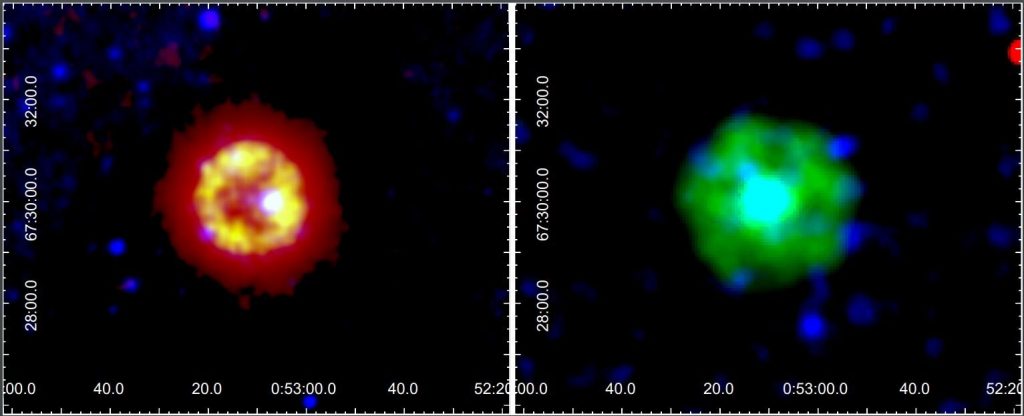
This most recent work shows that the central star, J005311, formed due to the collision of two white dwarfs. Generally, this type of collision causes a supernova and the destruction of both stars. Sometimes, one or both stars might manage to survive such a cataclysmic event. Even rarer, the two stars can merge, and that is what happened in this instance.
Of course, a rare occurrence wouldn’t be enough to merit our attention. In this event, the resulting star emitted unusual X-rays and appeared brighter than expected. These attributes, along with that incredibly strong wind, show that J005311 is actually too massive to be considered a white dwarf now. Additionally, it contains unusual amounts of the elements silicon, sulfur, and neon, making it an unknown type of star. And it’s also incredibly unstable and unlikely to exist for more than 10,000 years.
As for the nebula itself, per the paper: [T]he mass of IRAS 00500+6713 will likely remain above the Chandrasekhar limit. Its fate will therefore be to undergo core-collapse and to form a neutron star. Over the course of this event, IRAS 00500+6713 will manage to produce its second [supernova], possibly in the form of a fast blue optical transient.
This story is another of those “we’ve now seen one of these and need to see more” type stories. We’ll keep an eye out for further developments and studies.
Today is turning into a day of reporting on things that go bump and flash in the night. From colliding galaxies to colliding stars, we now turn to a small star that let off an amazing flare.
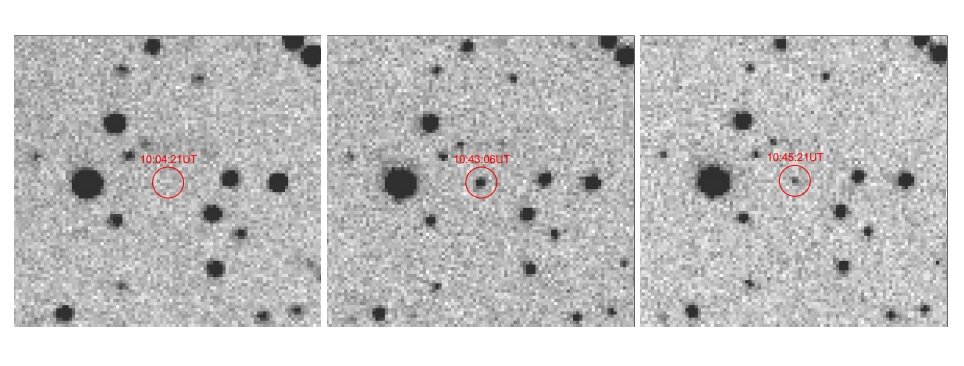
Located just 471 light-years away, the star SDSS J013333.08+003223.7 is a tiny cool dwarf star that in a brief moment gave off ten times the light of our Sun. This star is roughly 1/3 the mass of our Sun and is typically about 3000 degrees cooler. These kinds of small stars are some of the most common in the universe, and they are also some of the longest-lived. We also know small stars can have planets, raising the question, “Can these small, cool but very common and long-lasting stars host planets with life?”
To answer this question, we need to understand how stable they are.
Magnetic fields are one of the hardest things to understand in science. Trying to model how magnetic fields change and misbehave from a theoretical perspective just isn’t possible yet. Instead, we need to watch a lot of different stars to see what kinds of magnetic field driven flares occur. This kind of survey is currently being conducted by a collaboration of Chinese and French researchers using the Xinglong Observatory. This little star’s amazing flare lasted nearly four hours, and if the star had habitable worlds in the direction the flare was pointed, they would have been blasted with dangerous amounts of solar radiation during this event.
Because these stars are so small and faint, any habitable world would need to be snuggled up close to the star for warmth. This closeness puts them in considerable peril if a flare goes off. And with this research, we know just how bad a flare can be.
The next big question is, how common are giant flares? If they are sufficiently rare, we can imagine a society evolving on a habitable world, and developing protection measures to survive these flares. If the flares are common, however, life could be knocked back to its starting block with each new flare.
We hope the survey is able to answer these questions about flare frequency and power quickly, but until then, science has provided an amazing scenario for fiction to explore.
One of astronomy’s greatest frustrations is the sheer distance to even the nearest objects. We want to know what exoplanets actually look like and study sunspots on other stars. Unfortunately, the light-years of emptiness between our solar system and its nearest neighbors make directly seeing details generally impossible. Nevertheless, we do the best we can, and sometimes, we’re able to figure out details through logical deductions that would make Sherlock Holmes proud.
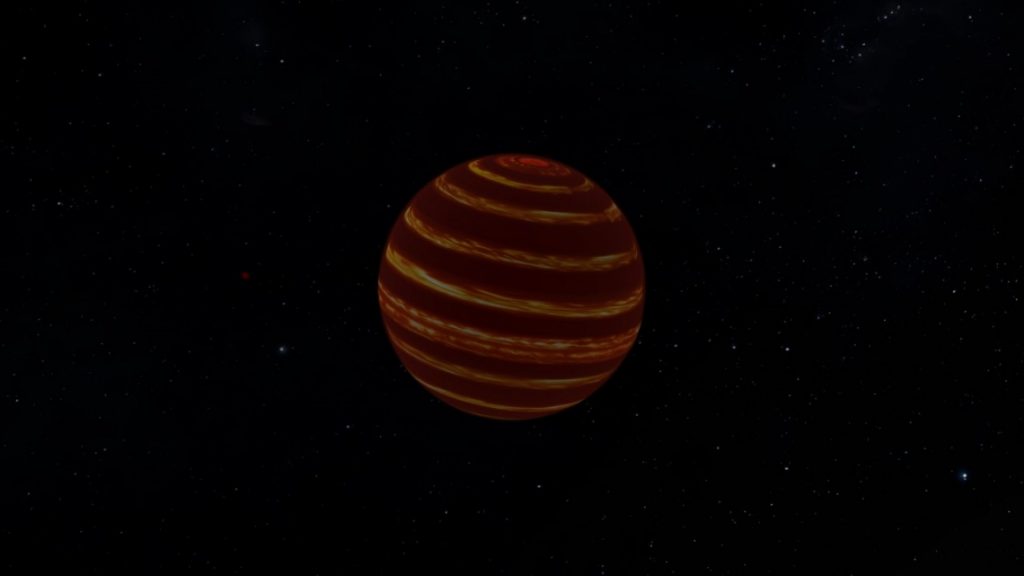
One of my favorite mysteries involves brown dwarfs. These objects are roughly the same diameter as Jupiter but pack in as much as 80 to 100 times its mass and are capable of undergoing short periods of nuclear fusion as they burn heavy hydrogen. Because they are very small and very faint, they are very hard to observe, and basic questions like do they have hot and cool bands like Jupiter or convection cells and spots like the Sun… well, we haven’t been able to answer those questions. At least until now.
A new paper in The Astrophysical Journal by Faniel Apai, Domenico Nardiello, and Luigi Bedin describes changes in light from the brown dwarf Luhman 16B that were recorded over 100 rotations.
If the stars have spots, they will vary in brightness more significantly than if they have stripes. Their data shows that this brown dwarf’s changes in brightness during rotation are consistent with it being banded like Jupiter.
According to Apai: Wind patterns and large-scale atmospheric circulation often have profound effects on planetary atmospheres, from Earth’s climate to Jupiter’s appearance, and now we know that such large-scale atmospheric jets also shape brown dwarf atmospheres. Knowing how the winds blow and redistribute heat in one of the best-studied and closest brown dwarfs helps us to understand the climates, temperature extremes, and evolution of brown dwarfs in general.
The technique used in this study will be used to study other brown dwarfs as we look to understand these weird objects that bridge between gas giants and red dwarf stars.
From the very big planetary-like body to the very small planetary-like body, we go now to new research coming out about Ryugu, our second favorite asteroid this last year. While analysis of the returned sample is currently underway, scientists are already working on data received from the spacecraft’s instruments to learn more about the history of the asteroid.
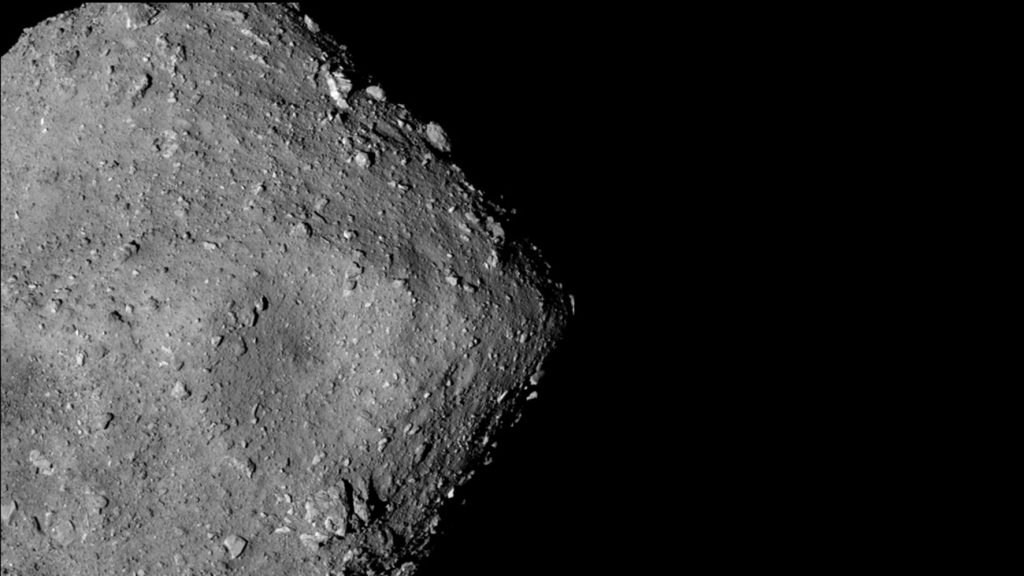
In a new paper published in Nature Astronomy, researchers examine why Ryugu seems to contain fewer water-bearing minerals than other asteroids we’ve studied. Since asteroids seem to be the broken up bits of larger bodies, in most cases, this lack of water must go directly back to the parent body of Ryugu.
Study co-author Ralph Millliken explains: One of the things we’re trying to understand is the distribution of water in the early solar system, and how that water may have been delivered to Earth. Water-bearing asteroids are thought to have played a role in that, so by studying Ryugu up close and returning samples from it, we can better understand the abundance and history of water-bearing minerals on these kinds of asteroids.
In fact, one of the reasons Ryugu was chosen as a sampling target for Hayabusa2 was the assumption that Ryugu was a particular type of asteroid that had water-bearing minerals and organic compounds; the kind of asteroid that is the parent body for meteorites bearing carbonaceous chondrites that brought water to Earth.
Instead, Ryugu seems to have lost its water at some point in its history. Perhaps the parent body dried out. Perhaps some sort of catastrophic disruption blew Ryugu apart, and it re-formed as the rubble pile asteroid it is today, but its water evaporated during the event. Or maybe Ryugu had some close calls with the Sun and dried up that way.
Now remember how Hayabusa2 took a shot at Ryugu, blowing a small crater into its surface to get underneath? Turns out that it’s dry there, too. This means it’s not likely to be that Sun-based hypothesis. Milliken goes on to explain: You’d expect high-temperature heating from the sun to happen mostly at the surface and not penetrate too far into the subsurface. But what we see is that the surface and subsurface are pretty similar and both are relatively poor in water, which brings us back to the idea that it was Ryugu’s parent body that had been altered.
One possible answer down; at least two more to go. Of course, everything could change once the physical samples are analyzed in the lab. Remote sensing is great, but the hands-on aspects of science can bring everything into focus and answer the question of just how Ryugu lost its water. And maybe even help us understand how Earth got its water.
A few weeks ago, we brought you a story about how spiders in space build their webs in the absence of gravity and/or light. Without gravity, spiders in the dark would orient their webs any which way; without gravity but with light, spiders oriented their webs with their heads down from the light. Humans don’t build webs, but we do tend to rely on gravity for everything. So what happens when we cannot tell which way is up?
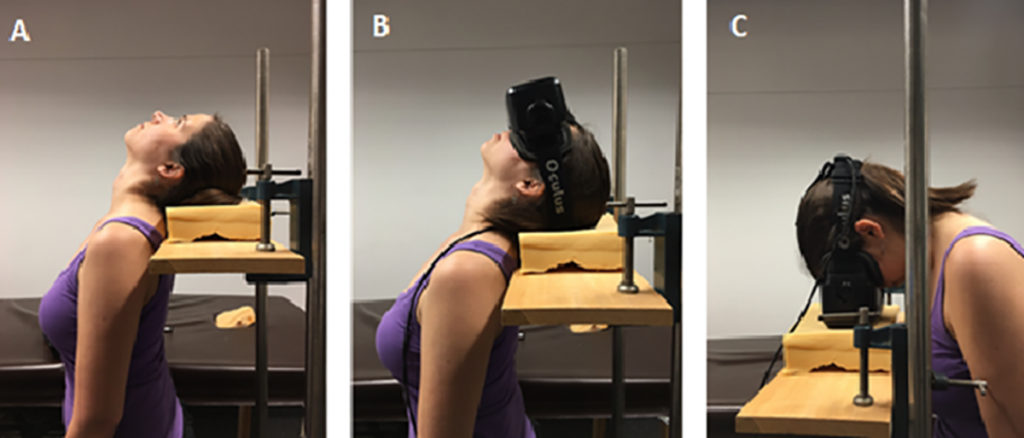
Researchers at York University’s Centre for Vision Research recently published a paper in the journal PLOS ONE on the results of their work using virtual reality to simulate the loss of gravitational orientation in humans. The press release explains that the participants had to “lie down in a virtual environment that was tilted so that the visual ‘up’ was above their head and not aligned with gravity.”
As a result, the team found that there were two distinct groups of people: those that perceived they were standing up vertically and those that persisted in sensing they were lying down. The former group reported that they were moving faster and further in the simulation than the latter group.
Co-author and Professor Laurence Harris noted: The findings reported in this paper could be helpful when we land people on the Moon again, on Mars, or on comets or asteroids, as low-gravity environments might lead some people to interpret their self-motion differently – with potentially catastrophic results.
Additionally, he pointed out: These findings may also help us to better understand and predict why astronauts may misestimate how far they have moved in a given situation, especially in the microgravity of space.
In our final story of the day, we bring you news of future dogs digging on Mars — robotic dogs, that is.
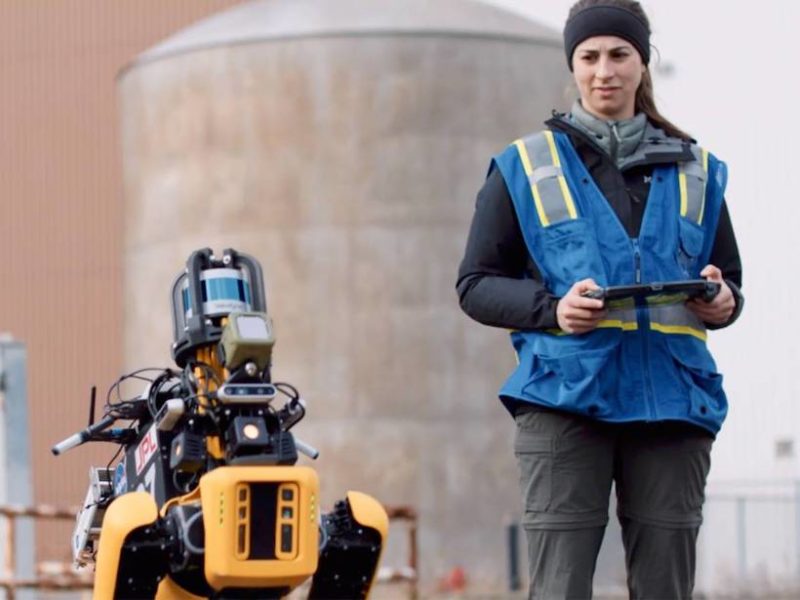
In the past two years, we’ve learned that digging on Mars is not an easy task. The InSight Mission has tried extremely hard and failed spectacularly. Now, as we look to the future, planetary scientists are taking lessons from the agile robot dogs, cheetahs, and other critters being created by Boston Dynamics.
Currently, one of these robot dogs can be found at CalTech being put through its paces. It is hoped that one of these dogs, dubbed “Autonomous Spot” or Au-Spot, will be able to descend through steep cave entrances and even dig. These robots can travel at 5 km/h which is 38 times faster than Curiosity and would allow them to cover in one hour a distance greater than what Curiosity explored all last year.
At this point, they are still at the robot training stage, and they are using artificial intelligence to help them learn how to handle different kinds of obstacles and adapt to new problems. There is a long way to go before one of these robots will be ready to travel to the red planet, but I for one welcome our new robot Rovers and look forward to Spot digging up Mars.
This has been the Daily Space.
Learn More
Hubble Releases Galaxy Merger Montage
- Hubble image release
- “Star cluster formation in the most extreme environments: insights from the HiPEEC survey,” A. Adamo et al., 2020 December, Monthly Notices of the Royal Astronomical Society
New Type of Star Found in Distant Nebula
- Phys.org article
- “X-rays observations of a super-Chandrasekhar object reveal an ONe and a CO white dwarf merger product embedded in a putative SN Iax remnant,” Lidia M. Oskinova et al., 2020 December 14
Super Flare of An Ultracool Star Detected
- Phys.org article
- “A ΔR∼9.5 mag Super Flare of An Ultracool Star Detected by SVOM/GWAC System,” L.P. Xin et al., 2020 December 28, accepted by The Astrophysical Journal (preprint on arxiv.org)
Winds and Jet Streams Found on the Closest Brown Dwarf
- The University of Arizona press release
- “TESS Observations of the Luhman 16 AB Brown Dwarf System: Rotational Periods, Lightcurve Evolution, and Zonal Circulation,” Dániel Apai, Domenico Nardiello, and Luigi R. Bedin, 2021 January 7, The Astrophysical Journal
Remote Sensing Finds Water Loss on Ryugu
- Brown University press release
- “Thermally altered subsurface material of asteroid (162173) Ryugu,” K. Kitazato, R. E. Milliken, and Y. Tsuda, 2021 January 4, Nature Astronomy
Virtual Reality Study Shows How Humans Perceive Gravity Differently
- York University press release
- “When gravity is not where it should be: How perceived orientation affects visual self-motion processing,” Meaghan McManus and, Laurence R. Harris, 2021 January 6, PLOS ONE
Robotic Dogs May Dig Into Martian Caves
Credits
Written by Pamela Gay and Beth Johnson
Hosted by Pamela Gay and Beth Johnson
Audio and Video Editing by Ally Pelphrey
Content Editing by Beth Johnson
Intro and Outro music by Kevin MacLeod, https://incompetech.com/music/


 We record most shows live, on Twitch. Follow us today to get alerts when we go live.
We record most shows live, on Twitch. Follow us today to get alerts when we go live.